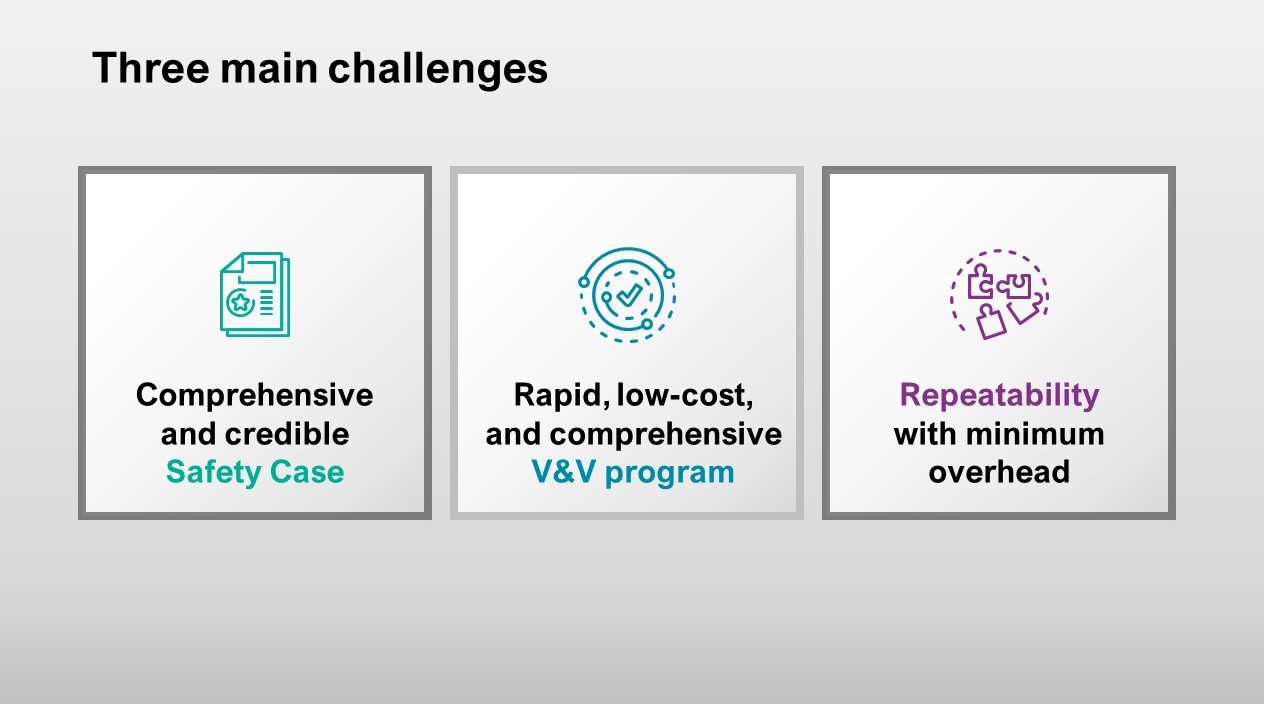The autonomous vehicle (AV) industry is rapidly evolving, and AV technology developers are at the forefront of this exciting yet challenging endeavor. Ensuring the safety and reliability of AVs is paramount, and achieving this goal requires addressing three key challenges:
- Building a Comprehensive Safety Case:
Public trust in AVs hinges on their safety credentials. The AV industry needs robust safety mechanisms and methods in place, along with clear demonstrations of their effectiveness. This involves rigorous testing, both in the real world and through sophisticated simulations, to continuously strengthen the safety argument for AVs. - Validating AVs Quickly and Affordably:
Traditionally, validating safety involved extensive real-world testing, which can be expensive, time consuming, and yet inadequate. The key lies in achieving a judicious mix of real-world and virtual testing environments. While real-world driving will continue to be a strong source of signal – and it is important to harvest maximum value from it – it is necessary to complement it with highly sophisticated virtual testing. - Ensuring Scalable and Repeatable Validation Processes:
As AV development progresses, validation processes need to be adaptable and reusable across different contexts. Imagine a well-oiled machine that can efficiently re-validate the safety of diverse AV applications without starting from scratch each time.

Optimizing the Validation Process: A Three-Part Strategy
- Strategic Use of Real-World Data:
Real-world driving data is crucial, but gathering it extensively can be costly and impractical. The goal is to extract maximum value from each mile driven through advanced data analysis tools that can dissect and leverage this information efficiently, ultimately enhancing the overall validation process. - Scaling Virtual Testing:
Anyone who is serious about AVs is already engaged in virtual testing. There is no more debate about the need and benefits of virtual testing. However, the state of practice in virtual testing is still far below its full potential. It is crucial to achieve high efficiency and value from virtual testing. This involves, at minimum, automated generation of valid scenarios at scale, steering of virtual tests towards high-value test cases, and analysis of millions of test results in an effective manner. - Achieving Comprehensive Operational Design Domain (ODD) Coverage:
The ODD is the specific set of conditions under which an AV is designed to operate safely (e.g., weather, traffic, geographical location). Validating the AV across its entire ODD is essential. This involves creating detailed ODD coverage maps and utilizing efficient testing methodologies to ensure all relevant scenarios within the designated operational domain are thoroughly tested and validated.
Advanced Tools for Enhanced Validation
Foretellix offers a suite of tools and accompanying methodologies specifically designed to enhance the value of real-world and virtual testing, as well as to connect them into a seamless whole. The tools can:
- Analyze Real-World Driving Data:
After ingesting real-world driving logs, they identify scenarios, their distributions, and anomalies, streamlining the data analysis process for more efficient validation and identifying gaps in ODD Coverage, to be filled in via virtual testing. - Replicate Real-World Scenarios in Virtual Environments:
Features such as “Smart Replay” enable fuzzing of scenarios far beyond the state of practice. Smart Replay enables changes to not just actor trajectories in the recordings, but also to actor behaviors (e.g. what if the actor had changed lanes instead of braking?), introduction of new actors, new risks, and potentially replaying the situation at different map locations. - Generate Diverse Testing Scenarios:
Advanced scenario generation tools create thousands of unique and detailed test cases, facilitating comprehensive safety validation. These tools understand the physics and rules of driving, ensuring the generation of valid and relevant scenarios. - Simulate Sensor Systems:
Integrating sensor simulation within testing environments creates a holistic validation approach that encompasses not just the vehicle’s decision-making algorithms but also its perception and sensor systems. - Navigate the ODD Efficiently:
By creating clear ODD coverage maps and utilizing specific methodologies, these tools efficiently navigate the vast test space, ensuring that validation efforts are precisely targeted, covering all necessary scenarios while identifying and filling any gaps.
The Future of AV Deployment: A Collaborative Effort
By strategically integrating these tools and methodologies into development, testing, and validation workflows, the AV industry can enter a new era of safety, efficiency, and scalability in AV deployment. Addressing the challenges of building a strong safety case, achieving efficient validation, and ensuring repeatability head-on will not only accelerate AV advancements but also solidify the safety and reliability of autonomous vehicles, paving the way for their successful integration into everyday life.
The vision of safe and cost-effective autonomous driving deployments is not a distant dream. Through strategic focus, technological innovation, and a relentless commitment to safety and efficiency, we have the roadmap to navigate the challenges and opportunities that lie ahead on the path toward autonomous mobility.


